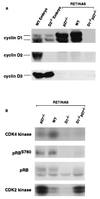Deletion of the p27Kip1 gene restores normal development in cyclin D1-deficient mice
- PMID: 11134518
- PMCID: PMC14567
- DOI: 10.1073/pnas.98.1.194
Deletion of the p27Kip1 gene restores normal development in cyclin D1-deficient mice
Abstract
D-type cyclins (cyclins D1, D2, and D3) are key components of cell cycle machinery in mammalian cells. These proteins are believed to drive cell cycle progression by associating with their kinase partners, cyclin-dependent kinases, and by directing phosphorylation of critical cellular substrates. In addition, D-cyclins play a kinase-independent role by sequestering cell cycle inhibitors p27(Kip1) and p21(Cip1). In the past, we and others generated cyclin D1-deficient mice and have shown that these mice display developmental abnormalities, hypoplastic retinas, and pregnancy-insensitive mammary glands. To test the significance of cyclin D1-p27(Kip1) interaction within a living mouse, we crossed cyclin D1-deficient mice with mice lacking p27(Kip1), and we generated double-mutant cyclin D1(-/-)p27(-/-) animals. Here we report that ablation of p27(Kip1) restores essentially normal development in cyclin D1-deficient mice. Our results provide genetic evidence that p27(Kip1) functions downstream of cyclin D1.
Figures





References
-
- Sherr C J. Trends Biochem Sci. 1995;20:187–190. - PubMed
-
- Bartkova J, Lukas J, Strauss M, Bartek J. Oncogene. 1995;10:775–778. - PubMed
-
- Motokura T, Bloom T, Kim H G, Juppner H, Ruderman J V, Kronenberg H M, Arnold A. Nature (London) 1991;350:512–515. - PubMed
-
- Dickson C, Fantl V, Gillett C, Brookes S, Bartek J, Smith R, Fisher C, Barnes D, Peters G. Cancer Lett. 1995;90:43–50. - PubMed
-
- Weinstat-Saslow D, Merino M J, Manrow R E, Lawrence J A, Bluth R F, Wittenbel K D, Simpson J F, Page D L, Steeg P S. Nat Med. 1995;1:1257–1260. - PubMed
Publication types
MeSH terms
Substances
Grants and funding
LinkOut - more resources
Full Text Sources
Molecular Biology Databases
Research Materials
Miscellaneous

